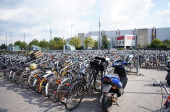
On the cusp of Czechoslovakia's division, Prague was home to approximately 1.2 million residents. Three decades later, in 2021, the population hovered around 1.28 million. Does this apparent
stability imply that global population growth isn't affecting the Czech capital?
According to insights from the Prague Institute of Planning and Development, the reality is quite the opposite, especially in the long term. Instead of remaining stagnant, as it has over the past thirty years, the city is poised for significant population growth over the next thirty years.
By 2050, it is estimated that Prague's population will swell to 1.7 million, gaining approximately 400,000 more inhabitants. Prague's growth has been considered "above-average" in recent years compared to other European cities and is leading among former Eastern bloc cities.
Marek Vácha, spokesperson for the Institute of Planning and Development (IPR), explained, "Future development will be influenced primarily by population migration, which applies to cities in general. Every year, nine thousand more people move to Prague than leave. In addition, two and a half thousand more children are born in Prague every year than people that pass away."
Despite global overpopulation concerns due to the world's threefold increase since 1950, IPR reassures both locals and foreigners in Prague that this shouldn't be a significant worry. The city is well-equipped to accommodate this growth, thanks to its infrastructure and development measures that have been put in place.
Prague's population growth in recent years has been significantly driven by foreign migration. Without immigration by foreigners, the city's population would either be decreasing or stagnant.
The number of foreigners in Prague has tripled since 2001, with almost 20% of the city's residents being non-Czech citizens. Factors contributing to this surge include the conflict in Ukraine, leading over 300,000 Ukrainians to seek refuge in Czechia, with a significant portion choosing Prague as their new home.
Americans are also joining the Prague community, with an estimated increase from 4,000 in 2016 to over 10,000 in recent times. Other nationalities, such as Germans, Slovaks, and Poles, have also become prominent among Prague's residents.
In addition, an IPR report highlights that "in recent years, there has been a significant increase in the number of foreigners from relatively poorer EU countries with higher unemployment rates," including immigrants from Bulgaria, Romania, Greece, and other EU member states.
One challenge noted by IPR is the potential of an aging population: "Despite growth in recent years, it is still evident that total fertility rates are still below the pan-European average and below the level of simple reproduction."
However, due to immigration, Prague enjoys a relatively younger population compared to the national average. In 2020, the average age in Prague was 42.0, while it was 42.6 in the whole of Czechia. While the country's demographics are expected to age incrementally over time, Prague's rapid population expansion will help counteract this aging trend. Photo by Visions of Domino, Wikimedia commons.



































